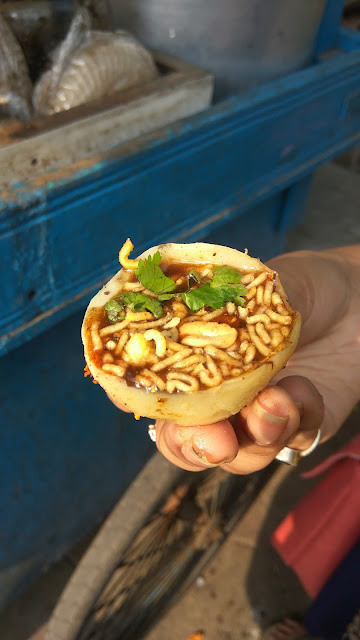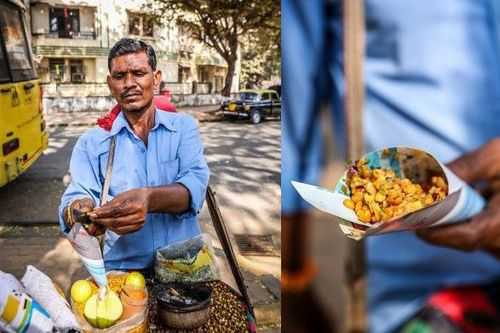Potatoes - Bengali's lifeline to Street Food
Be it the "Aloo" in Biryani or the humble "Alur Dom", Bengalis can't live without their fair share of potatoes. And at times, we are known to be quite fierce over our love for the spud. Below are a few of the favorite creations to tantalize Kolkata's tastebuds ever.
 |
| Alu Gappa at Rabindra Bharati University |
Alu Gappa or phuchka on steroids. We have all had and known about phuchka/gol gappa/pani puri/gupchup from our childhood days. But there is a little known hidden gem of a street food variation to the simple old phuchka that is just too good to leave out. Just think of it as the phuchka inside out with the potato being the casing and the flour puri missing.
A boiled potato is halved and scooped. Then filled with a tangy spicy mixture of nuts, sev, various herbs and in some cases potatoes itself. Topped with the customary tamarind water, it is a heavenly tasting twist on our regular phuchka.
 |
| Aloo Kabli |
Aloo Kabli or spicy aloo chaat is a very popular street food of Kolkata, might remind you of your school days. It is a part of traditional bengali street food that is served on these leaves of the Shaal tree, called”Shaal Pata" in Bengali. These leaves are usually formed into coned and secured with a toothpick, and food such as alu-kabuli (Potato and chickpeas), phuchka etc are served on this. The sweet & sour chutney and the green chilies mix to create an delighted smell of freshness, which I have never got from any dish. The spices make a brilliant hot and sour combination, and of course the potatoes muttar and chana add to the joy of having it. It gives me magical and refreshing and stir up all the marvelous cravings for the tasty, tangy flavors of street food.
Aloo Dum has many variations but this one would remind you Vivekananda park, Lake Kali Bari road where the roadside stalls would come up with some gorgeous fiery dish that leaves you all teary not to mention pining for water on one hand and asking form seconds on the other.
Potato, was not on the high priority list of vegetables for the Bengalis, it still really is not. Warren Hastings , the Governor general in 1790, received a basket of potatoes as a novelty gift from the Dutch , who took the credit of introducing potatoes to Bengal. The Story goes that Lord Amherst , had potatoes planted in the “Park of Barrackpore”. Bengalis took to the root vegetable with much enthusiasm. The starchy softness of the potatoes worked well as a perfect contrast to sharp taste of mustard seeds and cumin used in Bengali cooking. The Bengali aristocracy adopted “potato” as symbol of superiority and westernized cuisine. By 1860, it was the main ingredient in the region’s cooking. Potato slowly started traveling inland from Bengal.
Potato, was not on the high priority list of vegetables for the Bengalis, it still really is not. Warren Hastings , the Governor general in 1790, received a basket of potatoes as a novelty gift from the Dutch , who took the credit of introducing potatoes to Bengal. The Story goes that Lord Amherst , had potatoes planted in the “Park of Barrackpore”. Bengalis took to the root vegetable with much enthusiasm. The starchy softness of the potatoes worked well as a perfect contrast to sharp taste of mustard seeds and cumin used in Bengali cooking. The Bengali aristocracy adopted “potato” as symbol of superiority and westernized cuisine. By 1860, it was the main ingredient in the region’s cooking. Potato slowly started traveling inland from Bengal.
The “Nanbais” recreated their ” Dum Pukht” on the western fringes of the “Hugli” using simpler methods . Instead of cooking over night, they incorporated the Bengali technique of dry steaming . Spices were replaced, dry ginger and fennel powder gave way to roasted cumin and potato replaced turnips and thus the “Aloor Dom” was born.



Comments
Post a Comment